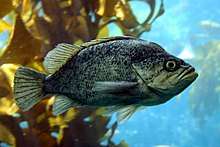Sebastes atrovirens
Sebastes atrovirens is a species of fish in the rockfish family known by the common name kelp rockfish. It is native to the Pacific Ocean along the coast of California in the United States and Baja California in Mexico.[1]
| Sebastes atrovirens | |
|---|---|
 | |
| Scientific classification | |
| Kingdom: | |
| Phylum: | |
| Class: | |
| Order: | |
| Family: | |
| Genus: | |
| Species: | S. atrovirens |
| Binomial name | |
| Sebastes atrovirens | |
| Wikimedia Commons has media related to Sebastes atrovirens. |
Description
This species reaches about 42 centimeters in length. Its life span is up to 15[2] to 20[1] or even 25 years. Individuals may be tan, brown, green, reddish, blackish, whitish, or brown-mottled. The snout has an "up-turned" look.[3] This species was recently moved from the Sebastes subgenus Mebarus[4] to Pteropodus, which also includes brown, gopher, copper, black-and-yellow, calico, quillback, China, and grass rockfishes.[5] Like some other rockfish, this species can produce an auditory signal in the form of a low-frequency pulsing noise.[6]
Distribution
This marine fish is distributed from Sonoma County, California, south to central Baja California. The climate is subtropical. It lives in coastal waters up to 42 meters deep, but usually not more than about 12 meters. Its habitat includes kelp beds and rocky seabeds.[1] It commonly associates with several other species of rockfish in this habitat, but it is more closely associated with the kelp than the others.[3] During the day it often rests on the kelp blades, sometimes upside down.[2] The main kelp species is Macrocystis pyrifera, the giant kelp. Other brown algaes in the habitat can include Pterygophora californica, Cystoseira osmundacea, and species of Desmarestia.[7] It is also known from artificial habitat types, such as oil rigs.[3]
Diet
The diet of the fish is rich in crustaceans[3] such as the isopod Pentidotea resecata,[7] as well as cephalopods and gastropods,[2] and it is known to prey on juvenile blue rockfish (Sebastes mystinus)[3] and plainfin midshipmen (Porichthys notatus).[7] It does most of its hunting at night.[3] In captivity, larvae have been reared on diets of Brachionus plicatilis, a rotifer, with supplements of copepods and veligers as they develop. The nauplius of the brine shrimp Artemia salina becomes the main food later.[5] Captive adults can be maintained on chopped squid[8] and live prey such as the night smelt (Spirinchus starksi).[7]
Spawning
Spawning starts in February in the northern part of its range, and in March farther south.[3] A female will mate with multiple males and can store sperm, yielding broods of eggs that have multiple fathers.[8] Like other fish of its genus, this species is viviparous.[1] The gravid female expels her whole brood at once, only during the night.[8] The larva is between 4 and 5 millimeters long at birth. It still has a small bit of yolk or oil on its belly which is absorbed within a few days. It quickly develops its head spines. It has some pigmentation at birth in the form of melanophores and xanthophores and develops more as it grows.[5]
Role as prey
This rockfish is an important prey item for many other animals. The larva is consumed by siphonophores and chaetognaths.[2] The juvenile is food for other fish, such as lingcod, cabezon, and salmon, as well as many birds, pinnipeds, and porpoises. The adult is prey for sharks, dolphins, and seals.[3] Additionally, this species is taken in spearfishing[3] and angling.[2]
References
- Froese, R. and D. Pauly, Eds. Sebastes atrovirens. FishBase. 2011.
- Essential Fish Habitat: West Coast Groundfish Draft Revised Appendix. Habitat/Ecosystem Team, West Coast Groundfish. Northwest Fisheries Science Center, National Marine Fisheries Service, NOAA. 1998. pg. 100.
- Abbreviated Life History of Kelp Rockfish (Sebastes atrovirens). Archived 2013-06-05 at the Wayback Machine California Department of Fish and Game.
- Li, Z., et al. (2006). Phylogeny of members of the rockfish (Sebastes) subgenus Pteropodus and their relatives. Can. J. Zool. 84 527–36.
- Watson, W. and L. L. Robertson. 2004. Development of kelp rockfish Sebastes atrovirens (Jordan and Gilbert 1880), and brown rockfish, S. auriculatus (Girard 1854), from birth to pelagic juvenile stage, with notes on early larval development of black-and-yellow rockfish, S. chrysomelas (Jordan and Gilbert 1880), reared in the laboratory (Pisces: Sebastidae). NOAA Prof. Paper NMFS 3, 30 pp.
- Širović, A., et al. (2009). Rockfish sounds and their potential use for population monitoring in the Southern California Bight. ICES Journal of Marine Science 66(6) 981-990.
- Van Dykhuizen, G. S. (1983). Activity patterns and feeding chronology of the kelp rockfish, Sebastes atrovirens, in a central California kelp forest. Thesis. San Jose State University.
- Sogard, S. M., et al. (2008). Multiple paternity in viviparous kelp rockfish, Sebastes atrovirens. Environ Biol Fish 81 7-13.
External links
- Photos of Sebastes atrovirens on Sealife Collection